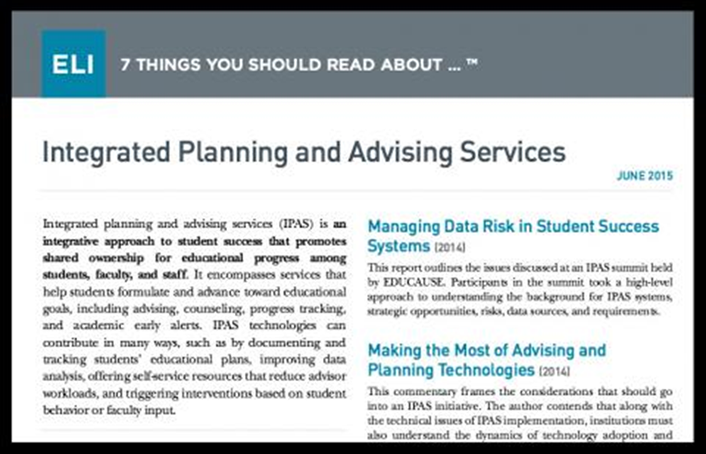
One way to gauge how post-secondary education is evolving is by determining to what extent institutions are adopting a learning-centered focus. Evidence of this abounds—and two still fairly recent developments in this area are digital badging and integrated student advising systems.
Badging offers encouragement and incentives to learning, while at the same time enabling the learner to take stock of progress and make informed decisions about next steps. An advising system that is integrated provides a richer, more complete picture of the learner’s situation, again enabling better, more informed decisions about what happens next.
The ELI has produced publications on these topics and is pleased to be able to announce that they are now publicly available.

You've probably at least heard about digital badging, and perhaps are actively involved with programs that are awarding them. But is badging equally useful in all contexts? Where does badging make sense, and where does it not?
In this ELI brief, a team of researchers from Indiana University take a close look at current digital badging efforts in an effort to understand the context where they work and where they don’t. Their research tracked 29 badging projects, all of whom received funding as a result of their success in the 2012 Badges for Lifelong Learning competition which was organized by the Digital Media and Learning (DML) initiative at the John D. and Catherine T. MacArthur Foundation, with additional funding from the Bill & Melinda Gates Foundation. Their research “yielded six general conclusions that we hope others will find useful when attempting to design systems for creating open digital badges that are widely valued.” This is an important study for anyone thinking about launching a badging program or who is currently conducting one.

Integrated advising systems are new, complex, and burgeoning with potential. It is a emerging technology that is developing at a rapid pace. Even its name is morphing: it was commonly called IPAS at the time this publication was produced (“integrated planning and advising services”) but since then has become “iPASS” or “Integrated Planning and Advising for Student Success”. Whatever you might wish to call it, in this document, it is defined as “an integrative approach to student success that promotes shared ownership for educational progress among students, faculty, and staff.” The notion of integration may be one of its most important dimensions, seeking to bring together disparate data to serve a variety of advising contexts.
This publication lists the seven most helpful and useful resources on integrated advising systems. A few of the resources listed include the EDUCAUSE research hub, a slide presentation providing an overview of the iPASS “movement,” and a web page from the Community College Resource Center.
7 Things You Should Read About is available to ELI members; non-members have access after 90 days. It's a companion publication to the well-known ELI 7 Things You Should Know About series. Each issue identifies seven key resources on an important topic in post-secondary teaching and learning.
Malcolm Brown, Director, EDUCAUSE Learning Initiative
